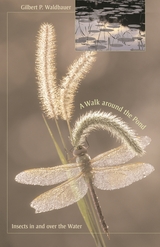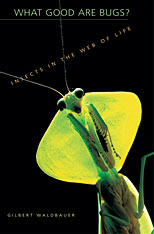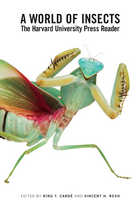
When the first birds appeared on earth about 150 million years ago, the insects were here to greet them. Inevitably the two groups came to exploit each other, and as the eons passed, they became increasingly enmeshed in a complex web of interrelationships--birds eating bugs, blood-sucking insects feeding on birds, parasitic insects infesting birds, and birds struggling to rid themselves of the parasites. In The Birder's Bug Book Gilbert Waldbauer, a veteran entomologist and an accomplished birdwatcher, describes these and many other interactions between birds and insects. A beguiling blend of anecdote, ornithology, and entomology, rendered in the engaging style that has won over scientists and amateur naturalists alike, this book is an excellent introduction to the intricate interplay of insects and birds.
With the birds and the bees it's not so much sex as mutual exploitation. Most birds feed mainly on insects, taking them from the air, from vegetation, and from deep within wood. The insects fight back by camouflaging themselves or by mimicking insects that birds find unpalatable. Many insects suck blood from birds or infest them, lodging in their feathers and nests. The birds fight back by preening, by taking dust or water baths to discourage lice and other bugs, and even by rubbing themselves with ants, whose formic acid repels many insects.
As entertaining as it is informative, The Birder's Bug Book will appeal to all those interested in birds, bugs, and natural history. Profusely illustrated with drawings and color photographs, this book offers a cornucopia of facts about the life history and behavior of insects and birds.


Insects that are the least bit social may gather in modest groups, like the dozen or so sawfly larvae feeding on a pine needle, or they may form huge masses, like a swarm of migratory locusts in Africa or a cloud of mayflies at the edge of a midwestern lake or river. Why these insects get together and what they get out of their associations are questions finely and fully considered in this learned and entertaining look at the group behavior and social lives of a wide array of bugs.
The groups that Gilbert Waldbauer discusses here are not as complex or tightly organized as the better-known societies of termites, wasps, ants, and bees. Some, like the mayflies, come together merely because they emerge from the water in the same place at the same time. But others, like swarms of locusts, are loosely organized, the individual insects congregating to migrate together for distances of hundreds of miles. And yet others form a simple cooperative society, such as the colony of tent caterpillars that weaves a silken tent to house the whole group.
Waldbauer tells us how individuals in these and other insect aggregations communicate (or don't), how they coordinate their efforts, how some congregate the better to mate, how some groups improve the temperature and humidity of their microenvironment, and how others safeguard themselves (or the future of their kind) by amassing in such vast numbers as to confound predators.
As engaging and authoritative as Waldbauer's previous books, Millions of Monarchs, Bunches of Beetles will enlighten and delight those who know their insects well and those who wish to know them better.

A water strider darts across a pond, its feet dimpling the surface tension; a giant water bug dives below, carrying his mate’s eggs on his back; hidden among plant roots on the silty bottom, a dragonfly larva stalks unwary minnows. Barely skimming the surface, in the air above the pond, swarm mayflies with diaphanous wings. Take this walk around the pond with Gilbert Waldbauer and discover the most amazingly diverse inhabitants of the freshwater world.
In his hallmark companionable style, Waldbauer introduces us to the aquatic insects that have colonized ponds, lakes, streams, and rivers, especially those in North America. Along the way we learn about the diverse forms these arthropods take, as well as their remarkable modes of life—how they have radiated into every imaginable niche in the water environment, and how they cope with the challenges such an environment poses to respiration, vision, thermoregulation, and reproduction. We encounter the caddis fly larva building its protective case and camouflaging it with stream detritus; green darner dragonflies mating midair in an acrobatic wheel formation; ants that have adapted to the tiny water environment within a pitcher plant; and insects whose adaptations to the aquatic lifestyle are furnishing biomaterials engineers with ideas for future applications in industry and consumer goods.
While learning about the evolution, natural history, and ecology of these insects, readers also discover more than a little about the scientists who study them.

We shriek about them, slap and spray them, and generally think of insects (when we think of them at all) as pests. Yet, if all insects, or even a critical few, were to disappear--if there were none to pollinate plants, serve as food for other animals, dispose of dead organisms, and perform other ecologically essential tasks--virtually all the ecosystems on earth, the webs of life, would unravel. This book, the first to catalogue ecologically important insects by their roles, gives us an enlightening look at how insects work in ecosystems--what they do, how they live, and how they make life as we know it possible.
In What Good Are Bugs? Gilbert Waldbauer combines anecdotes from entomological history with insights into the intimate workings of the natural world, describing the intriguing and sometimes amazing behavior of these tiny creatures. He weaves a colorful, richly textured picture of beneficial insect life on earth, from ants sowing their "hanging gardens" on Amazonian shrubs and trees to the sacred scarab of ancient Egypt burying balls of cattle dung full of undigested seeds, from the cactus-eating caterpillar (aptly called Cactoblastis) controlling the spread of the prickly pear to the prodigious honey bee and the "sanitary officers of the field"--the fly maggots, ants, beetles, and caterpillars that help decompose and recycle dung, carrion, and dead plants. As entertaining as it is informative, this charmingly illustrated volume captures the full sweep of insects' integral place in the web of life.

As we follow the path of a giant water bug or peer over the wing of a gypsy moth, we glimpse our world anew, at once shrunk and magnified. Owing to their size alone, insects’ experience of the world is radically different from ours. Air to them is as viscous as water to us. The predicament of size, along with the dizzying diversity of insects and their status as arguably the most successful organisms on earth, have inspired passion and eloquence in some of the world’s most innovative scientists. A World of Insects showcases classic works on insect behavior, physiology, and ecology published over half a century by Harvard University Press.
James Costa, Vincent Dethier, Thomas Eisner, Lee Goff, Bernd Heinrich, Bert Hölldobler, Kenneth Roeder, Andrew Ross, Thomas Seeley, Karl von Frisch, Gilbert Waldbauer, E. O. Wilson, and Mark Winston—each writer, in his unique voice, paints a close-up portrait of the ways insects explore their environment, outmaneuver their enemies, mate, and care for kin.
Selected by two world-class entomologists, these essays offer compelling descriptions of insect cooperation and warfare, the search for ancient insect DNA in amber, and the energy economics of hot-blooded insects. They also discuss the impact—for good and ill—of insects on our food supply, their role in crime scene investigation, and the popular fascination with pheromones, killer bees, and fire ants. Each entry begins with commentary on the authors, their topics, and the latest research in the field.
READERS
Browse our collection.
PUBLISHERS
See BiblioVault's publisher services.
STUDENT SERVICES
Files for college accessibility offices.
UChicago Accessibility Resources
home | accessibility | search | about | contact us
BiblioVault ® 2001 - 2024
The University of Chicago Press









